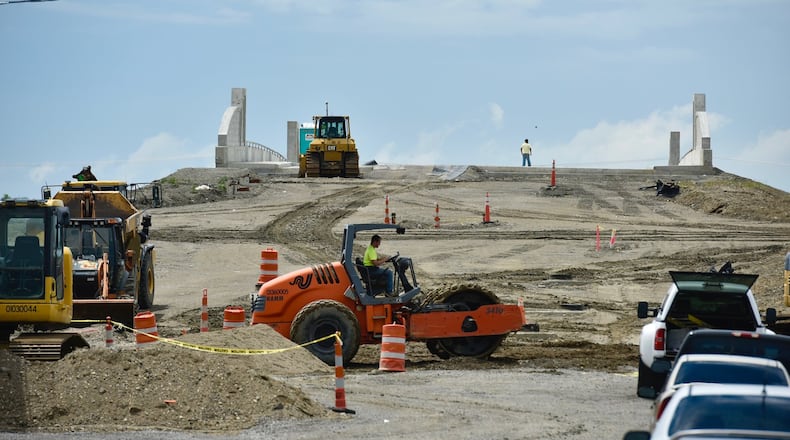Wilkens said the secret to his success is “knowledge” and experience with matching projects to available grants and local match money is always a plus.
“It’s an art and a science getting these grants,” Wilkens told the Journal-News. “Just because you’ve got a project doesn’t mean you’re going to get money.”
His largest win in recent years is $11.6 million, nearly half the cost for the “fix” to the Liberty Way interchange at Interstate 75 that is under construction now.
It rankles officials here that a change is even necessary since the $40 million interchange is only a decade old. When the interchange was first imagined the design being built now was preferred by locals, but rejected by the state because it terminates into a local road.
Wilkens surmises the large grant is at least partially due to the state’s original mistake.
“I don’t know the total thinking, the numbers matched, the numbers worked, the traffic volume’s high enough, the accident history is great enough,” Wilkens said. “The state recognized there is a problem now, the weave and so forth, was it a portion of it, yeah I’d say that was a big portion of it.”
Wilkens has secured several other large grants in recent years like $5.6 million for the $7 million improvement to Ohio 747 in Liberty Twp. and $5.3 million for the $7.8 million widening of Cincinnati-Dayton Road in Old West Chester. The county only had to pay $82,535 for the $4.8 million Yankee Road in Liberty Twp. five years ago.
The vast majority of the grant-worthy projects have been in the two largest townships, Liberty and West Chester have the financial ability to put up matching money through their tax increment financing districts and fit other criteria smaller jurisdictions for the most part can’t.
“When we’ve got TIFS available that has helped,” Wilkens said. “But when you put it into perspective those are the high growth, you’ve got the high volume, high accidents and they qualify easier. The bulk of the projects being in those townships is because the bulk of the traffic is in those townships.”
Wilkens handles projects on county and township roads but the cities do their own roadwork. Hamilton Director of Engineering Rich Engle said since 2017 they have spent $48.4 million on street resurfacing, bridge replacements and upgrades, South Hamilton Crossing, the Jim Blount overpass, Main Street improvements and traffic signal upgrades. They won $28.3 million in grants to support these projects.
“The city of Hamilton recognizes these grant funds as taxpayer dollars and utilizes them prudently,” Engle said. “We would not have been able to accomplish the list of projects completed in the last 5 years without the grant funding. This is especially true of the South Hamilton Crossing which received 56.3% grant funding for the construction cost.”
Middletown has spent $21.3 million and grants covered 65% of the cost or nearly $14 million. Middletown’s biggest road problem was solved with the 0.25%, 10-year income tax levy voters approved last November. It is allowing the city this year and next to launch a blitz of road resurfacing including $51.6 million to fix a third (217) of the 621 lane miles in the city.
Scott Tadych, director of Public Works, explained why the city could not have sought grants to help with this campaign.
“That project is almost exclusively local residential streets, so there are very limited funds out there as far as grants for that because they don’t have high traffic,” Tadych said. “It’s not a highway, it’s not a major arterial so there’s very little if any grant funds available for that type of project.”
Fairfield has received outside funding from the state, the Ohio Public Works Commission and federal funds covering 52% of its $14 million in major projects over the past five years. Public Works Director Ben Mann said the city has been successful largely because it is willing to provide matching funds.
“Outside funding is critical to the city for most projects beyond routine maintenance of our transportation system,” Mann said. “Without OKI, ODOT, and OPWC funding, it would be difficult for the city to fund major improvement projects that increase safety, reliability, and the efficiency of our transportation network.”
Oxford has had an 84.7% success rate since 2017 culling $6.48 million for $7.6 worth of work and the county’s smallest city Trenton has not received any outside funding for its projects.
About the Author

